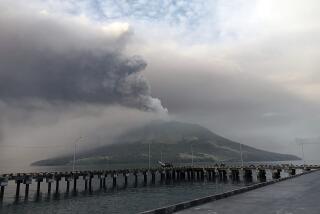Argentine town taking the fallout from volcano
- Share via
ESQUEL, ARGENTINA — This Patagonian winter resort town wears a mantle of white in the South American autumn. But it’s not from early snows.
Ash from the Chaiten volcano across the Andes in Chile has been falling on the Argentine side of the border since the volcano erupted last week -- its first eruption in thousands of years.
The onslaught of ash has yet to cause evacuations on the Argentine side, as it has in Chile. But it has closed schools, disrupted flights and shut down highways while raising health concerns in this city of 32,000 and other areas where the ash has fallen.
There has been a run on pharmaceutical masks and bottled water in Esquel, about 1,250 miles south of Buenos Aires. Residents complaining about irritated eyes, sore throats and breathing problems have been converging on doctors and clinics.
Although the ash flow decreased Wednesday, the realization is taking hold that the fine dust isn’t likely to go away anytime soon. Scientists say the volcano could keep on belching for weeks or months.
“We’re going to have to learn to live with this,” Mario Vargas, the vice governor of ash-covered Chubut province, told reporters.
Schools reopened Wednesday as the ash seemed to diminish after spectacular explosions Tuesday, when authorities feared that the mountain could collapse. But many parents and students here appeared confused and preoccupied. Some parents kept their children home from school.
“We saw a lot of kids going to school without masks, without protective glasses, and the wind was kicking up the ashes,” said Andrea Hernandez, a mother of two. “A lot of these kids’ parents don’t have the money to buy masks or mineral water or glasses for their kids.”
Gabriel Fresco, 14, said it wasn’t an especially productive school day. Maintenance workers couldn’t get all the dust out and students and staff members suffered from the effects of the ash.
Authorities sought to allay fears about health effects and contamination of drinking water. Officials said the ash, although irritating to the eyes and the respiratory system, was not toxic. They downplayed the possibility of long-term dangers posed by the volcanic debris and said noxious gases were not present in the atmospheric soup.
Several hundred people have arrived here from the Chilean hamlet of Futaleufu, once home to about 1,000. They seem bewildered, unprepared for a natural disaster that suddenly drove them out of their homes in a picturesque, quiet area, forcing them to flee across the Andes.
“We’re all sad, and it makes us sadder still to watch the television and see what this volcano has done, how it has destroyed our town and everything around it,” Rolando Moraga said.
Scientists continued monitoring the Chaiten volcano, but there was no consensus on what would happen next.
The great fear is a catastrophic explosion with hot flows of fast-moving gases and molten rock that could destroy much of the countryside in its path, including spectacular swaths of Chilean wilderness. An optimistic hypothesis is that the worst has passed and the mountain will calm gradually. But experts say the current state of periodic eruptions and ejections of gas, and even lava, could continue indefinitely.
“We don’t know how long this situation will last,” said Hugo Moreno, a Chilean volcanologist. “Only the volcano knows.”
--
Special correspondent Sosa reported from Esquel and Times staff writer McDonnell from Santa Cruz, Bolivia. Special correspondent Eva Vergara in Santiago, Chile, contributed to this report.
More to Read
Sign up for Essential California
The most important California stories and recommendations in your inbox every morning.
You may occasionally receive promotional content from the Los Angeles Times.










